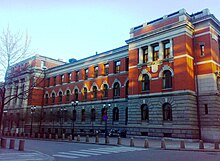
Law in Norway follows a civil law system. The Supreme Court is the highest in the nation, with 20 justices.

Law in Norway follows a civil law system. The Supreme Court is the highest in the nation, with 20 justices.
The highest level of law is the Constitution of 17 May 1814. Statutes made under the Constitution are subordinate to it. Regulations made under such a statute are subordinate to such law.
The first state-issued national Law-Code for Norway was Magnus Lagabøtes landslov (or the 'Code of the Norwegian Realm'), issued in 1274 by Magnus VI of Norway. It was followed in 1276 by the Magnus Lagabøtes bylov , issued by the same king. [1]
The Constitution of Norway was adopted on 16 May 1814 by the Norwegian Constituent Assembly at Eidsvoll.
Norwegian law, as well as the other Scandinavian legal systems, differ from their civil law continental counterparts by assigning a very high value on jurisprudence. Especially in private law, large parts of legal development are left to the Supreme Court. As an example, areas such as ordinary contract law are scarcely legislated by the Storting. Norwegian law, unlike many other civil law systems, are not codified in systematic codes. Although an attempt at codification was in the works from 1953 to 1999, the project was subsequently disbanded. [2]

In law, common law is the body of law created by judges and similar quasi-judicial tribunals by virtue of being stated in written opinions.

Constitutional law is a body of law which defines the role, powers, and structure of different entities within a state, namely, the executive, the parliament or legislature, and the judiciary; as well as the basic rights of citizens and, in federal countries such as the United States and Canada, the relationship between the central government and state, provincial, or territorial governments.

The United Kingdom has three distinctly different legal systems, each of which derives from a particular geographical area for a variety of historical reasons: English law, Scots law, Northern Ireland law, and, since 2007, calls for a fourth type, that of purely Welsh law as a result of Welsh devolution, with further calls for a Welsh justice system.
Case law, also used interchangeably with common law, is a law that is based on precedents, that is the judicial decisions from previous cases, rather than law based on constitutions, statutes, or regulations. Case law uses the detailed facts of a legal case that have been resolved by courts or similar tribunals. These past decisions are called "case law", or precedent. Stare decisis—a Latin phrase meaning "let the decision stand"—is the principle by which judges are bound to such past decisions, drawing on established judicial authority to formulate their positions.
In law, codification is the process of collecting and restating the law of a jurisdiction in certain areas, usually by subject, forming a legal code, i.e. a codex (book) of law.

The legal system of Canada is pluralist: its foundations lie in the English common law system, the French civil law system, and Indigenous law systems developed by the various Indigenous Nations.

The Frostating was an early Norwegian court. It was one of the four major Things in medieval Norway. The Frostating had its seat at Tinghaugen in what is now the municipality of Frosta in Trøndelag county, Norway. The name lives on in the present day Frostating Court of Appeal in Norway.

The primary and fundamental statement of laws in the Russian Federation is the Constitution of the Russian Federation. Statutes, like the Russian Civil Code and the Russian Criminal Code, are the predominant legal source of Russian laws.
In the United States, state law refers to the law of each separate U.S. state.

The legal system of Singapore is based on the English common law system. Major areas of law – particularly administrative law, contract law, equity and trust law, property law and tort law – are largely judge-made, though certain aspects have now been modified to some extent by statutes. However, other areas of law, such as criminal law, company law and family law, are almost completely statutory in nature.

Eidsivating was the name of one of the original Norwegian popular assemblies or Things. Historically, it was the site of court and assembly for the eastern parts of Norway.

In most legal jurisdictions, a supreme court, also known as a court of last resort, apex court, and highcourt of appeal, is the highest court within the hierarchy of courts. Broadly speaking, the decisions of a supreme court are binding on all other courts in a nation and are not subject to further review by any other court. Supreme courts typically function primarily as appellate courts, hearing appeals from decisions of lower trial courts, or from intermediate-level appellate courts. A Supreme Court can also, in certain circumstances, act as a court of original jurisdiction, however, this is typically limited to constitutional law.
Lithuanian law is a part of the legal system of Lithuania. It belongs to the civil law legal system, as opposed to the common law legal system. The legal system of Lithuania is based on epitomes of the French and German systems. The Lithuanian legal system is grounded on the principles laid out in the Constitution of the Republic of Lithuania and safeguarded by the Constitutional Court of the Republic of Lithuania.

The law of California consists of several levels, including constitutional, statutory, and regulatory law, as well as case law. The California Codes form the general statutory law, and most state agency regulations are available in the California Code of Regulations.

The law of Sweden is a civil law system, whose essence is manifested in its dependence on statutory law. Sweden's civil law tradition, as in the rest of Europe, is founded upon Roman law as codified in the Corpus Juris Civilis, but as developed within German law, rather than upon the Napoleonic Code. But, over time Sweden along with the other Scandinavian countries have deviated significantly from their classical Roman and German models. Instead, the Scandinavian countries together with Finland, the Faroe Islands, Greenland, Åland (self-governing) and Iceland may be said to have a special "Nordic" version of jurisprudence that is neither a truly civil law system nor a part of the British-derived common law legal system.
The law of Virginia consists of several levels of legal rules, including constitutional, statutory, regulatory, case law, and local laws. The Code of Virginia contains the codified legislation that define the general statutory laws for the Commonwealth.
The law of the U.S. state of Georgia consists of several levels, including constitutional, statutory, and regulatory law, as well as case law and local law. The Official Code of Georgia Annotated forms the general statutory law.

The law of Michigan consists of several levels, including constitutional, statutory, regulatory and case law. The Michigan Compiled Laws form the general statutory law.
The law of Washington consists of several levels, including constitutional, statutory, regulatory and case law, as well as local ordinances. The Revised Code of Washington forms the general statutory law.
Scandinavian law, also known as Nordic law, is the law of the five Nordic countries, namely Denmark, Finland, Iceland, Norway and Sweden. It is generally regarded as a subgroup of civil law or as an individual legal body in itself. Prior to the 19th century, the European countries were independent in their administering and legality. However, in 1872, the Nordic countries organised legislative cooperation. Especially in areas of contracts and commerce, as well as those concerned with family, nationality and extradition, the five states have obtained uniform legislation.